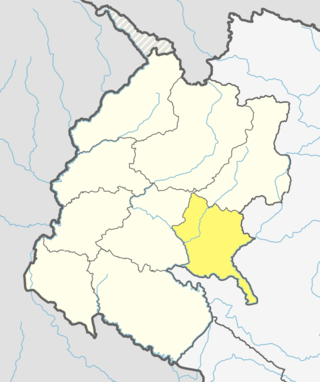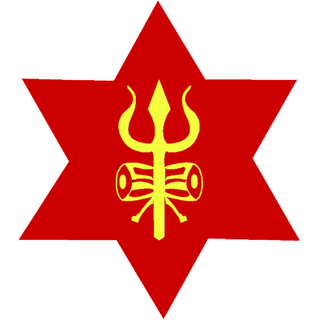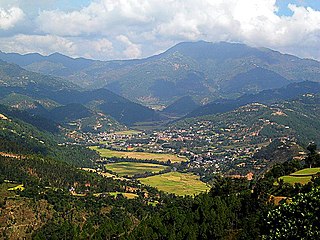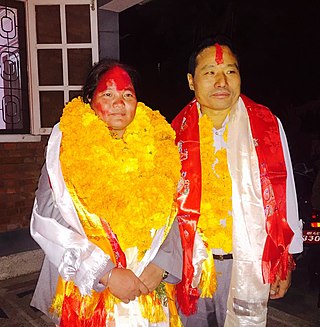
The Kingdom of Nepal was a Hindu kingdom in South Asia, formed in 1768 by the expansion of the Gorkha Kingdom, which lasted until 2008 when the kingdom became the Federal Democratic Republic of Nepal. It was also known as the Gorkha Empire, or sometimes Asal Hindustan. Founded by King Prithvi Narayan Shah, a Gorkha monarch who claimed to be of Khas Thakuri origin, it existed for 240 years until the abolition of the Nepalese monarchy in 2008. During this period, Nepal was formally under the rule of the Shah dynasty, which exercised varying degrees of power during the kingdom's existence.

The Nepali Civil War was a protracted armed conflict that took place in the former Kingdom of Nepal from 1996 to 2006. It saw countrywide fighting between the Government of Nepal and the Communist Party of Nepal (Maoist), with the latter making significant use of guerrilla warfare. The conflict began on 13 February 1996, when the CPN (Maoist) initiated an insurgency with the stated purpose of overthrowing the Nepali monarchy and establishing a people's republic; it ended with the signing of the Comprehensive Peace Accord on 21 November 2006.

Pushpa Kamal Dahal, alias Prachanda, is a Nepalese politician currently serving as the Prime Minister of Nepal. He previously held the prime ministerial post from 2008 to 2009 as the first prime minister of the Federal Democratic Republic of Nepal, and again from 2016 to 2017. He was elected as prime minister for the third time in 2022, following that year's elections.

The Communist Party of Nepal (Maoist Centre) (Nepali: नेपाल कम्युनिस्ट पार्टी (माओवादी केन्द्र)), abbreviated CPN (Maoist Centre), CPN-Maoist Centre, CPN Maoist Centre, or CPN (MC), is the third largest political party in Nepal and a member party of Socialist Front. It was founded in 1994 after breaking away from the Communist Party of Nepal (Unity Centre). The party launched an armed struggle in 1996 against the Nepalese government. In 2006, the party formally joined mainstream politics after signing a peace agreement following the 2006 Nepalese revolution.
Events from the year 2004 in Nepal.

Sher Bahadur Deuba is a Nepali politician and former prime minister of Nepal. He has also been serving as the president of the Nepali Congress since 2016. Deuba has served five terms as prime minister and is the Member of Parliament for the parliamentary constituency of Dadeldhura 1.

Achham is a district located in Sudurpashchim province of Nepal. It is one of the nine districts of the province. The district, with Mangalsen as its district headquarters, covers an area of 1,692 km2 and has a population (2011) of 257,477.

The Nepali Army, also referred as the Gorkhali Army, is the land service branch of the Nepali Armed Forces. After the Gorkha Kingdom was founded in 1559, its army was established in 1560, and was accordingly known as the Gorkhali Army. The army later became known as the Royal Nepali Army (RNA) following the Unification of Nepal, when the Gorkha Kingdom expanded its territory to include the whole country, by conquering and annexing the other states in the region, resulting in the establishment of a single united Hindu monarchy over all of Nepal. It was officially renamed simply to the Nepali Army on 28 May 2008, upon the abolition of the 240-year-old Nepalese monarchy, and of the 449-year-old rule of the Shah dynasty, shortly after the Nepalese Civil War.

Birtamod is a municipality in Jhapa District of Nepal. It is the commercial, educational and transport hub of Jhapa District. Sarnamati Bazar, Dhulabari Bazar, Dhaijan Bazar, Charali Bazar, Shivasatakshi Bazar, Kamatoli Bazar, Chakchaki Bazar and Surunga Bazar are some of the nearest local towns/settlements connected to Birtamod. It is one of the fastest growing cities in Nepal and one of the largest cities of Jhapa.
Mangalsen Nepali: मंगलसेन is a municipality and the capital of Achham District in Sudurpashchim Province, Nepal. It was established on 18 May 2014 by merger of the former Village development committees of Janalibandali, Kuntibandali, Oligaun, Jupu, Kalagaun into its current form. At the time of the 2011 Nepal census it had a population of 32,507 people living in 6,604 individual households.

Sandhikharka Municipality is the headquarter of Arghakhanchi District which lies in Lumbini Province of Nepal. The former village development committee (VDC) was converted into a municipality on 18 May 2014 by merging the existing Sandhikharka, Wangla, Narapani, Khanchikot, Kimadada, Argha and Dibharna VDCs evdo. It is located, in a valley surrounded by hills, in the western part of the capital, Kathmandu.

The Nepalese People's Liberation Army was the armed wing of the Communist Party of Nepal (Maoist). The PLA was founded in 2002, in the midst of the Nepalese Civil War initiated by the Maoists in 1996. The chief commander of the PLA during the war was Prachanda. On 12 September 2008, Nanda Kishor Pun was appointed new chief commander of the PLA, as Prachanda had become Prime Minister of Nepal. This move was in line with a pledge issued by the CPN(M), issued prior to the 2008 Constituent Assembly election, that their members elected to the Assembly would leave their PLA positions.
This is a timeline of the 1967–present Naxalite–Maoist insurgency in eastern India.

Sanphebagar Airport is a domestic airport located in Sanphebagar serving Achham District, a district in Sudurpashchim Province in Nepal.

The Sino-Nepalese War, also known as the Sino-Gorkha War and in Chinese as the campaign of Gorkha, was a war fought between the Qing dynasty of China and the Kingdom of Nepal in the late 18th century following an invasion of Tibet by the Nepalese Gorkhas. It was initially fought between Gorkhas and Tibetan armies in 1788 over a trade dispute related to a long-standing problem of low-quality coins manufactured by Nepal for Tibet. The Nepalese Army under Bahadur Shah plundered Tibet which was a Qing protectorate and Tibetans signed the Treaty of Kerung paying annual tribute to Nepal. However, Tibetans requested Chinese intervention and the Chinese imperial military forces under Fuk'anggan were sent to Tibet and repulsed the Gurkhas from the Tibetan plateau in 1792. Sino-Tibetan forces marched into Nepal up to Nuwakot but faced a strong Nepalese counterattack. Thus, both countries signed the Treaty of Betrawati as a stalemate. The war ended with Nepal accepting terms dictated by China. Nepal became a tribute state under Qing. Nepal paid tribute to China in 1792, 1794, 1795, 1823, 1842 and 1865. Both Nepal and Tibet had also agreed to accept the suzerainty of the Qing emperor.

Sanphebagar is a municipality in Achham District in Sudurpashchim Province of Nepal that was established on 18 May 2014 by merging the two former Village development committees Baijinath, Jalapadevi, Siddheswar, Mastamandau, Nawathana, Bhagyeshwar, Ridikot, Chandika. It lies on the bank of Budhi Ganga River. At the time of the 2011 Nepal census it had a population of 33,788 people living in 6,693 individual households. Sanphebagar is about 25 km north of the district headquarters of Mangalsen.
Events from the year 2002 in Nepal.

Barsaman Pun, also known by his nom de guerre Ananta, is a Nepali communist politician and former Minister for Energy, Water Resources and Irrigation. He is also a member of the Standing Committee in Nepal Communist Party (NCP). He has previously served as Minister of Finance and Minister of Peace and Reconstruction. He was a leader of the Communist Party of Nepal (Maoist-Centre) during the insurgency period and served as one of 4 deputy commanders of People's Liberation Army.

The 2004 Beni attack was one of the biggest attacks by the People's Liberation Army (PLA) of Communist Party of Nepal, Maoist, during the Nepalese Civil War (1996–2006). Almost the entire Western Division of the PLA, numbering around 3,500, attacked government positions in Beni, the district headquarters of Myagdi district in western Nepal, on 20 March 2004 at around 10 pm. Hundreds of civilians were used for logistics. Around 90 soldiers of the PLA and dozens of police and military personnel as well as civilians died. Multiple government buildings were destroyed and dozens of members of the civil service and government forces were kidnapped by the PLA.















